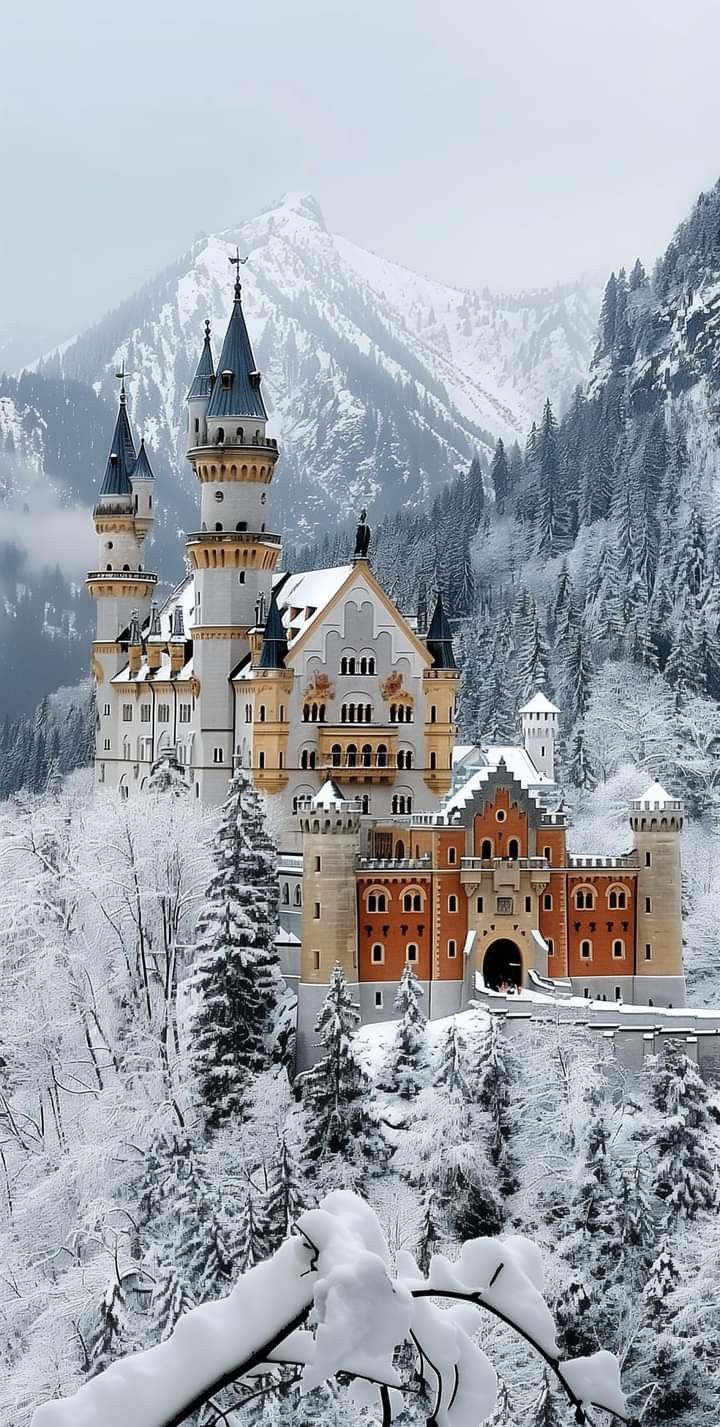Neuschwanstein Castle, Germany: A Fairytale Fortress Amidst the Bavarian Alps
Nestled high in the Bavarian Alps, Neuschwanstein Castle is one of the most recognized and enchanting castles in the world. With its striking spires, towering stone walls, and breathtaking mountain backdrop, it seems as though it has stepped out of a fairytale. The castle has captivated visitors for over a century, serving as an iconic symbol of the romantic and idealized vision of medieval castles. Built in the 19th century, Neuschwanstein Castle is not just an architectural masterpiece but also a symbol of the fantasy and dreams of its creator, King Ludwig II of Bavaria.
History of Neuschwanstein Castle
The story of Neuschwanstein Castle begins with King Ludwig II of Bavaria, often referred to as the “Fairy Tale King.” His fascination with medieval legends and Germanic mythology inspired him to create a castle that reflected the grandeur of the legendary castles he admired. Construction of Neuschwanstein began in 1869, though it was far from being finished when the king died in 1886 under mysterious circumstances. Despite the unfinished state of the castle, it has become one of the most popular tourist attractions in Germany.
The design of the castle was influenced by medieval castles but with a romantic twist. Ludwig’s love of the works of composer Richard Wagner and the opera world shaped the design, with many of the castle’s rooms inspired by Wagner’s operas. Ludwig II’s death left the castle unfinished, and after his death, it was opened to the public in 1886.
Architectural Features of Neuschwanstein Castle
Neuschwanstein Castle’s stunning architecture is part of its charm, and its design blends medieval-inspired elements with the artistic flair of the Romantic period. The castle is renowned for its fairytale-like appearance, as if it were the setting for a dreamlike story. Here are some key architectural features:
- The Towers and Spires: The castle’s most recognizable feature is its series of tall, pointed towers and spires. Inspired by medieval fortresses, these towers rise dramatically above the Bavarian landscape. The main tower, or Keep, reaches an impressive height of 92 meters (302 feet).
- The Interior Rooms: The interior of the castle is equally impressive, with rooms designed to evoke the grandeur of medieval Europe. The Throne Room is one of the most magnificent rooms, with its high ceiling, golden chandeliers, and ornate wall paintings. The Singing Hall is another striking room, decorated with scenes from Wagner’s operas.
- The Gatehouse and Entrance Hall: The entrance to Neuschwanstein Castle is marked by an imposing gatehouse with a grand arched doorway. The Entrance Hall leads into the castle’s central courtyard and features a dramatic staircase, giving visitors their first taste of the opulence within.
- The Views: The location of Neuschwanstein Castle is key to its magical charm. It sits atop a hill, offering panoramic views of the Alpsee Lake, the surrounding Hohenschwangau Valley, and the Alps. The setting is nothing short of breathtaking, making the castle seem almost otherworldly.
- The Bridge Over Pöllat Gorge: One of the most famous views of the castle comes from the Marienbrücke (Mary’s Bridge), which spans the Pöllat Gorge. This viewpoint offers a dramatic view of the castle perched above the gorge, creating the perfect backdrop for photos.
Significance of Neuschwanstein Castle
Neuschwanstein Castle is a remarkable testament to the vision and dreams of King Ludwig II. While it is a work of fantasy and an architectural marvel, it also holds deep significance as a symbol of the Romanticism movement that was prevalent in Europe during the 19th century. Here are a few key aspects of its significance:
- A Symbol of Romanticism: The castle’s design reflects the ideals of the Romanticism movement, which emphasized the beauty of nature, the mystery of the past, and an idealized version of medieval life. Ludwig II’s vision of a perfect, dream-like castle became a manifestation of these ideals.
- King Ludwig II’s Legacy: King Ludwig II’s obsession with the past, mythology, and his admiration for the operas of Richard Wagner are all reflected in Neuschwanstein Castle. The king’s personal obsession with the construction of this castle and its role in his fantasies marked a significant part of his legacy, despite the financial strain it placed on Bavaria.
- Cultural and Architectural Landmark: Neuschwanstein Castle has become one of Germany’s most important cultural landmarks. It symbolizes both Bavarian heritage and the romanticized view of medieval times, representing the blending of history, art, and mythology.
- Popular Culture Icon: Neuschwanstein Castle is perhaps best known today as the inspiration for Disney’s Sleeping Beauty Castle. Its whimsical appearance has made it a symbol of fairy tales worldwide, and its image has appeared in various films, TV shows, and advertisements.
Key Facts About Neuschwanstein Castle
- Location: Neuschwanstein Castle is located in Bavaria, southern Germany, near the town of Hohenschwangau. The nearest large city is Munich, about 120 kilometers (75 miles) to the north.
- Construction Time: Construction of the castle began in 1869 but was never completed. Only a few rooms, including the Throne Room and Singing Hall, were fully finished before King Ludwig II’s death in 1886.
- Visitor Numbers: Neuschwanstein Castle attracts more than 1.3 million visitors annually, making it one of the most popular tourist destinations in Germany. Its fairytale appearance continues to fascinate people from all over the world.
- Architectural Style: The castle is built in a Romanesque Revival style, with elements inspired by medieval castles, but it also incorporates more modern features and the aesthetic preferences of King Ludwig II.
- Mary’s Bridge: The Marienbrücke (Mary’s Bridge) offers the best viewpoint of Neuschwanstein Castle. The bridge spans the Pöllat Gorge, providing breathtaking views of the castle and surrounding landscape.
- Inspiration for Disney: Neuschwanstein Castle served as the inspiration for Sleeping Beauty Castle in Disneyland. Its whimsical architecture and picturesque location have made it an iconic symbol of fantasy and fairytales.
- The Castle’s Name: The name “Neuschwanstein” means “New Swan Stone.” It is derived from Lohengrin, the swan knight from Wagner’s opera, which influenced Ludwig II’s vision for the castle.
Impact on Society and Tourism
Neuschwanstein Castle is a cultural and architectural treasure, not just for Germany but for the world. Its romanticized medieval design, combined with its stunning location in the Bavarian Alps, has made it a symbol of beauty and fantasy. It continues to draw millions of tourists annually, eager to explore its enchanting rooms and gardens and to experience the dreamlike world that King Ludwig II sought to create.
The castle also serves as an important part of Bavaria’s cultural heritage. It showcases the grandeur and ambition of King Ludwig II, who despite his controversial reign, left behind a lasting legacy in the form of this fairytale fortress. Neuschwanstein Castle is a symbol of the power of imagination, the allure of medieval legends, and the enduring appeal of fantasy in both architecture and culture.
Conclusion: A Dreamlike Legacy
Neuschwanstein Castle is more than just a historical monument; it is a symbol of romantic fantasy, artistic vision, and architectural splendor. Its breathtaking beauty, inspiring views, and rich history make it a captivating destination for tourists from around the world. As the inspiration for fairy tales and a cultural icon, Neuschwanstein Castle remains a shining example of how one man’s dreams can create a timeless legacy that continues to capture the imagination of millions.










